GetResponse Review: Accessible and Design-Oriented
Easiest email marketing software to use, and the highest scoring in our research
If you click to purchase a product or service based on our independent recommendations and impartial reviews, we may receive a commission. Learn more
Best for
Easiest to use and best overall
GetResponse is a great email marketing platform. It’s the easiest to use (according to our independent testers), but also holds its own when it comes to the more technical stuff. Plus, it has some really nice-looking designs up its sleeve.
Of course, GetResponse isn’t perfect. In this review, we’ll be looking at what held it back from scoring a perfect 5/5, as well as all the things we think add a lot of value to a business. By the end, you’ll be in no doubt as to whether it’s the right option for you.
Quick Overview of GetResponse
Key Info
- Starting price: $15/month
- Free plan: No, but a free trial
- Number of contacts on cheapest plan: 1000
- Number of emails on cheapest plan: Unlimited
Our users said: ‘Overall I really liked using Get Response. I found the dashboard very easy to use, especially when it came to creating a campaign.’
We’d recommend GetResponse for pretty much anyone who knows they should be doing some kind of email marketing for their business, but isn’t sure where to start, or how to go about it. Maybe you’ve already tested the water, but never quite got into the swing of it.
GetResponse is very easy to use, with an affordable starting price. It’ll steer you through the process of building things you might not have known you needed – like email funnels and automations – which can end up being your most valuable email activity, and something that can just tick along in the background. Design-wise, you’re covered while you’re building by yourself, thanks to great templates and easy drag-and-drop building. You’re also covered if you later get a designer to build you some custom templates or blocks. Here’s how it performed in our testing:
GetResponse might not be right for you if you’re a more experienced email marketer with specific functionality in mind. There are some things that GetResponse either might not have, or may hold back for a more expensive plan (see the cons below), which will stop the platform being your best value option.
More Information
- GetResponse is our top-rated email marketing platform overall. See how it performs next to its competitors in our Best Email Marketing Services comparison.
Pros & Cons
| Pros | Cons |
|---|---|
| Easiest email marketing platform to use. Ideal for total beginners, with no prior email marketing (or email designing) experience. It was our users’ favorite in testing! | Limited automations on the cheapest plan. Ecommerce businesses in particular would need the Plus plan or above. |
| Great design options. Build your own, work from a template, or upload a custom HTML template (or HTML code blocks). You can also adjust the mobile version of emails, which is a pretty rare feature | Transactional emails only available on the Max (custom priced) plan, and as a paid add-on. You can provide transactional emails through your ecommerce platform, but it's ideal to have everything sent from ‘under one roof’. What's more, other software offers transactional emails at a much lower price point. |
| Only platform to integrate with Etsy. GetResponse is ideal for anyone selling through this popular marketplace. | Glass ceiling with analytics/reporting. GetResponse has a pretty strong offering in this area, but unlike other platforms, it doesn’t have any third party plugins/integrations for when you might want to take this up a notch (e.g. Google Analytics) |
Ease of Use
To compare the email marketing software we write about fairly, we’ve put them all through our user testing process.
For this testing, a group of users worked with each platform for an hour, with set tasks such as:
- Adding new contacts to a list
- Designing an email to suit a (fictitious) brand
- Scheduling and personalizing this email
- Adding automation and A/B testing options
GetResponse received the highest score for ease of use in our testing – an impressive 4.4/5. It’s the easiest to use email marketing platform we’ve come across, and the one that’s most suitable for beginners.
Here’s what our users had to say:
The way the dashboard is designed is so intuitive and clear.
The actual email campaign creation was really easy, and there were lots of things that were for example editing text. It was just all laid out well – it was really clear where everything was, and it felt really flexible, which I really liked and can see being of massive benefit to others.
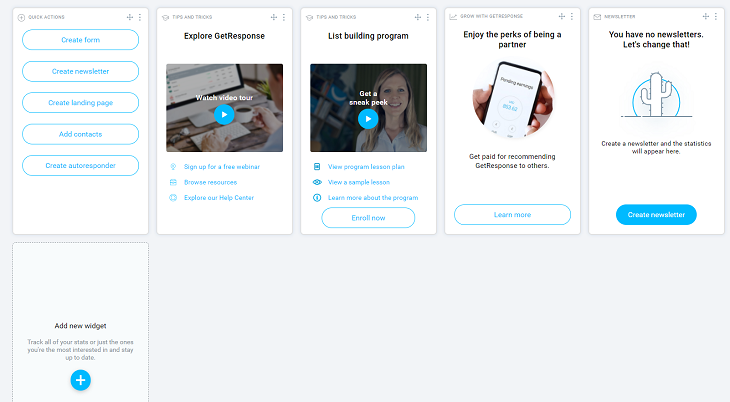
One random but quite irritating problem we encountered when setting up our contact lists, however, is that this name has to be completely unique – if another GetResponse account has already used it, you won’t be able to. Of course, this is relatively easy to get around – it just isn’t a problem we’ve come across previously.
But generally speaking, GetResponse does a great job of making the more complex stuff accessible for beginners.
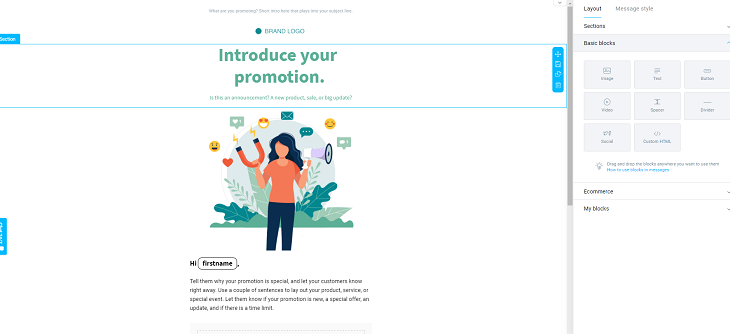
Pricing and Value for Money
GetResponse offers four different price plans. The price you pay for each plan depends on the size of your contact list. You can reach up to 100,000 contacts on the first three plans, and after that point you’ll need to upgrade to the custom-priced Max plan (if you haven’t already):
| Number of Contacts | Basic | Plus | Professional | Max |
|---|---|---|---|---|
| 1,000 | $15 | $49 | $99 | Custom Pricing |
| 2,500 | $25 | $59 | $119 | |
| 5,000 | $45 | $79 | $139 | |
| 10,000 | $65 | $95 | $165 | |
| 25,000 | $145 | $179 | $255 | |
| 50,000 | $250 | $299 | $370 | |
| 100,000 | $450 | $499 | $580 |
All plans offer unlimited email sends, and GetResponse also has a free trial period of 30 days (no credit card details required – cancel anytime). Once your trial has lapsed, you’ll just find you can’t actually send any emails, and your account will lie ‘dormant’ until you decide to upgrade.
Big discounts for longer contracts
Before we look at how GetResponse’s prices compare to those of its competitors, we thought it would be worth noting the size of the discount you can get with GetResponse if you commit to a longer contract.
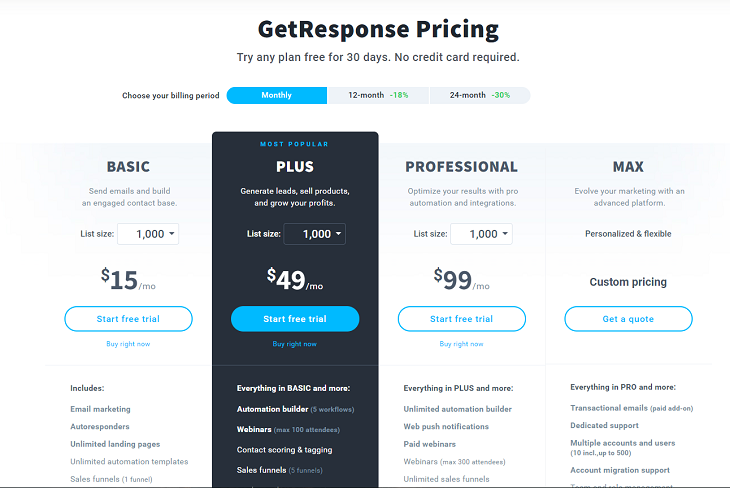
Price vs competitors
Here’s how GetResponse’s pricing, and value for money score, compares with the other five platforms in our top six:
| Cheapest plan cost (per month) | Number of contacts on cheapest plan | Number of emails on cheapest plan (per month) | Value for money score (out of 5) | |
|---|---|---|---|---|
| GetResponse | $15 | 1,000 | Unlimited | 4.0 |
| ActiveCampaign | $15 | 500 | Unlimited | 4.6 |
| Mailchimp | $9.99 | 500 | 5,000 | 3.2 |
| MailerLite | $10 | 1,000 | Unlimited (when contact list under 50,000) | 3.2 |
| Constant Contact | $20 | 500 | Unlimited | 4.4 |
| Sendinblue | $25 | Unlimited | 10,000 | 3.7 |
Value for money
While GetResponse compares favorably to other brands when you look at the starting price and subscriber/email send limits, the fact that it withholds key automations for the more expensive plans means it isn’t the best value platform we’ve come across. Plus, transactional emails are withheld for the top tier only.
Both of these limitations affect ecommerce businesses in particular. For those who aren’t selling online, however, the Basic plan does offer good value.
Email Design
Design was another area where GetResponse really shone, scoring 4.7/5 in testing – the highest of any platform we’ve assessed. It’s the only provider we’ve tested to include all of the following:
- Sending GIFS
- Survey sends
- The option of embedding forms
- A free image library
When it comes to design, GetResponse perfects the balance of quantity of options and quality of product.
Use a template, custom HTML design, or a mix
In terms of quantity, firstly there are several ways you can approach designing an email:
- Use one of the 110+ email templates as a base
- Start with a ‘blank template’ and build it in blocks
- Upload a custom HTML email
- Use a previous template
Even if you start with a template, you can still add custom HTML blocks. You can even ‘bookmark’ these in the ‘My Blocks’ section so you can quickly add them in the future, without having to reupload.
Designing your email
Building your email is simple – it’s just a matter of dragging and dropping elements, such as images, into the right place within the email. No design skills needed.
Most email marketing software offers drag-and-drop building, but this is particularly smooth and intuitive. GetResponse even pre-populates the footer of the email with the information you used to create your account – a nice touch!
Design-wise, you can absolutely use one of GetResponse’s pre-designed templates, without looking like your business is stuck in 2006 (believe us – the same cannot be said for all email marketing platforms). Sure, some templates are nicer than others, but we love how each is labelled with the event it’s targeted at – making it particularly simple to skim through and choose one to preview.

GetResponse only includes 17 fonts, but you can upload a custom one.
Marketing Tools
Designing a high-performing email comes down to more than just the look. It’s all about iterating on what works well, testing, learning, and using clever automation to build the perfect email funnels.
We analyzed these marketing tools specifically when comparing email marketing platforms, and GetResponse scored 4.5/5 in this area. A good score, certainly – but this was actually pretty middle-of-the-road compared to other platforms, with both MailerLite and Mailchimp having a very slight edge over GetResponse here.
Segmentation and automation
GetResponse has a wide range of automation options available. You can build your own custom one, or work from one of the 43 templates:
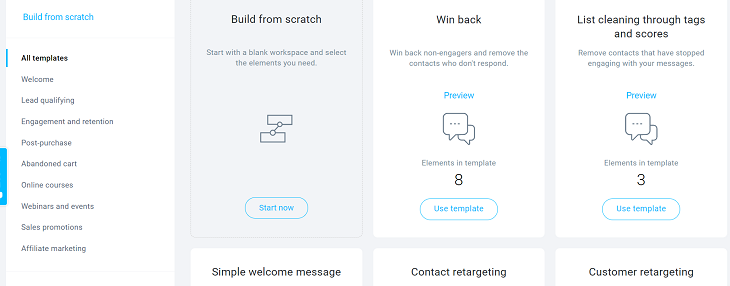
The downside is that a lot of the core automation options are withheld for the Plus plan and above:
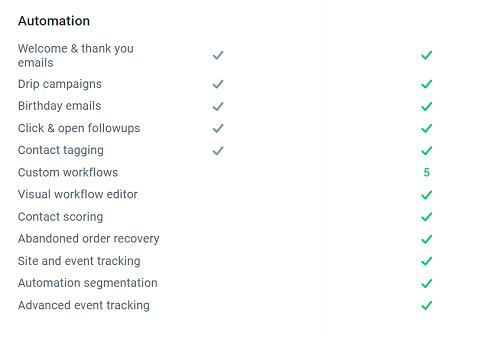
This means the Basic plan isn’t really a viable option for even very small ecommerce businesses. Mailchimp (the email marketing software we most recommend for ecommerce businesses) doesn’t withhold automations at any price point, and has a starting price of $9.99.
And despite GetResponse’s thorough explainer videos and useful prompts, our users found the automation a little tricky to get to grips with in testing. The word ‘overwhelming’ came up a few times:
The automation is somewhat overwhelming, with so much choice in pre-populated triggers. Although you can order and filter them, I was just overwhelmed, and wasn’t super clear which one I should be choosing.
A/B Testing
Unlike automations, A/B testing is an option on all plans. A/B testing is the process of splitting your contact list and sending a slightly different version of an email to each half, then comparing the results.
Testing in this way is essential for learning what your audience prefers – and the greater the scope for testing, the better. With GetResponse, you can test:
- Subject line variations
- Content variations (i.e. changes within the email itself, be it the design, the wording, or the images)
You cannot, however, test different send times, which can be a helpful tool for pinpointing exactly when your audience wants to hear from you. Sendinblue and MailChimp are the only platforms we’ve tested to offer all three options.
Analytics and reporting
GetResponse has a really visual reporting style, which makes email data really digestible for business owners who might not be overly familiar with the different types of data, and how to read them.
Drilling down into the more technical side of things, GetResponse offers:
- Standard campaign analytics – this includes open rate and click through rate (CTR). This is kind of the bread and butter of email marketing software, and we certainly wouldn’t recommend a platform that didn’t offer this level of basic analytics
- Ability to collect subscriber data (e.g. demographics) – this is done gradually, and over time. This is known as progressive profiling, and is key for achieving ‘layered targeting’, where you’re personalizing key mailouts to send to groups within similar demographics
- Platform tracking – so you can see how users are behaving on your site, and align this with what you’re sending them
- Engagement segmentation – whereby how people interact with your email determines what email they will receive next (e.g. anyone who doesn’t open the first one may get a follow-up)
Something GetResponse doesn’t offer is:
- Email click heat maps – these show where your subscribers are clicking on your email sends, and help you optimize them going forward.
Four out of five analytics features isn’t bad, but actually, every email marketing platform we tested offered at least four of these options. Constant Contact, Mailchimp, and MailerLite offer all five, giving them a slight edge over GetResponse here.
Content and Functionality Tools
GetResponse scored 3.9/5 for content and functionality tools in our research, which was below average, and makes this the platform’s weakest area.
But what exactly do we mean by content tools? This score refers to what GetResponse has to offer in terms of integrations with other platforms (both social media and ecommerce platforms), limits on number of emails and number of contacts, and whether it offers features like transactional emails.
Ecommerce and payments
If you run an online store, the ability to integrate your email marketing platform with your ecommerce platform is pretty essential. GetResponse integrates with:
- Etsy (the only email software with this integration)
- Magento
- Shopify
- Prestashop
- WooCommerce
Some big ecommerce players – including BigCommerce and Big Cartel – are missing from this list. But GetResponse is the only platform we’ve tested with a dedicated Etsy integration, so it’s the obvious choice for anyone currently selling on Etsy only.
GetResponse has more payment integrations than any other platform we’ve tested, supporting:
- PayPal
- Stripe
- Square
- Amazon Pay
Social media
You can integrate content from the following social media platforms into your GetResponse emails:
- YouTube
We found this to be a pretty standard offer across other email marketing platforms, with the exception of MailerLite, which goes the extra mile by also including Spotify, Strava and Snapchat options.
Other integrations
Unlike other platforms, however, GetResponse doesn’t offer extra reporting or analysis tools/integrations to level up your analytics game. Of course, you’ve still got the analytics that GetResponse provides itself – it’s just that you can’t expand beyond these if things really start to take off. And anything GetResponse lacks – like the email heat map we covered earlier – you’ll just have to do without.
Help and Support
GetResponse offers help and support via:
- 24/7 Live chat
There’s also phone support, but only for those on the custom-priced Max plan. In fact, if you’re on this plan, you also get Slack support (fancy) and a dedicated account manager, the idea being that this is someone who will give you personalized advice beyond simply troubleshooting.
GetResponse scored 4/5 for help and support in our testing. Again, this can’t be described as a bad score, but it was pretty average compared to competitors, some of which (Constant Contact and Sendinblue) offer phone support to all price tiers.
GetResponse Review: Summary
GetResponse is the easiest to use email marketing platform we’ve tested. It takes concepts that can be complex and jargon-filled, and turns them into simple steps, making it easier for those without marketing experience to harness the full power of email marketing.
It comes with some drawbacks – namely the lower value for money score that comes from offering a stripped-down Basic plan, plus the lack of some very specific reporting/testing tools – but ultimately, we very much recommend it.
If you’re an ecommerce business that’s not operating on Etsy or Shopify, however, Mailchimp may be a better option for you. It came out top in our research for ecommerce businesses specifically, but doesn’t gel so well with either of those platforms.
FAQs
What you’ll pay for GetResponse depends on the size of your contact list, and the plan you choose. The cheapest option is $15 per month for up to 1,000 subscribers, with the most expensive being over $580 per month. There are no limits on the volume of emails.
No, GetResponse doesn’t offer a free plan, although you can try it free for 30 days. If you want an email marketing provider, we recommend Mailchimp, while Sendinblue and MailerLite also have free plans.
GetResponse’s head office is in Gdańsk, Poland. It also has offices in Warsaw, Moscow, Wilmington, São Paulo, and Kuala Lumpur!


Leave a comment